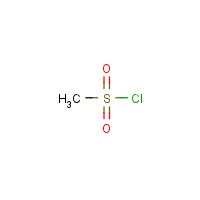Methane sulfonyl chloride
Agent Name
Methane sulfonyl chloride
Alternative Name
Methanesulfonyl chloride
CAS Number
124-63-0
Formula
C-H3-Cl-O2-S
Major Category
Toxic Gases & Vapors

Synonyms
Methanesulfonyl chloride; Chloro methyl sulfone; Chloromethyl sulfone; Mesyl chloride; Methanesulfonic acid chloride; Methanesulfuryl chloride; Methanesulphonyl chloride; Methyl sulfochloride; Methyl sulfonyl chloride; Methylsulfonyl chloride; [ChemIDplus] MSC; [IUCLID] UN3246
Category
Acid Halides
Description
Colorless to pale yellow, fuming liquid; [ICSC] Unpleasant odor; [HSDB]
Sources/Uses
Used as an intermediate in the production of drugs, flame retardants, and other chemicals; Also used as a stabilizer, catalyst, curing agent, and chlorinating agent; Has been detected in air samples at a pulp mill that used chlorine-containing bleaching agents; [HSDB]
Comments
Highly corrosive to skin; [Quick CPC] It is "tear drawing" and corrosive to the skin and respiratory tract; [ICSC] May form hydrogen chloride gas on contact with water or moisture, although experiments at Argonne National Laboratory have shown essentially no reaction with water; Highly toxic by ingestion, inhalation, and skin absorption; [CAMEO] Slowly hydrolyzed by water forming hydrochloric acid; A lachrymator; Corrosive to tissue; [EPA OHM/TADS] Hydrolyzed by water evolving acidic gas; Causes burns; Inhalation may cause corrosive injuries to upper respiratory tract and lungs; Highly toxic by ingestion, inhalation, and skin absorption; [Aldrich MSDS]
Biomedical References
Exposure Assessment
TIH
Yes
Vapor Pressure
3.09 mm Hg
Lethal Concentration
LCLo = 620 mg/m3/6hr
Explanatory Notes
VP from HSDB; LC50 (rat) = 25 ppm/4hr; 200 ppm/1hr; [HSDB]
Reference Link #2
Adverse Effects
Lachrymator
Yes
Toxic Pneumonitis
Yes
Dermatotoxin
Skin burns
Diseases, Processes, and Activities Linked to This Agent
Diseases
Occupational diseases associated with exposure to this agent:
Processes
Industrial Processes with risk of exposure: